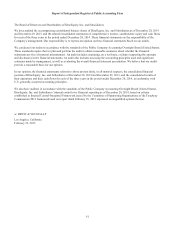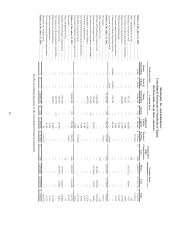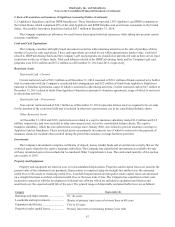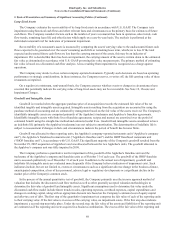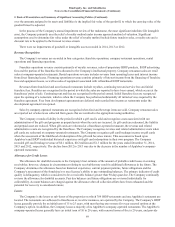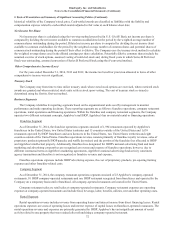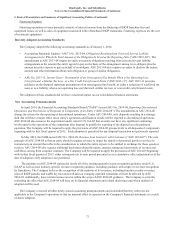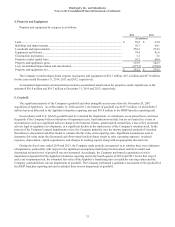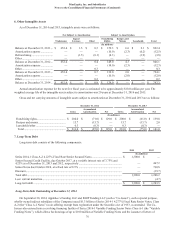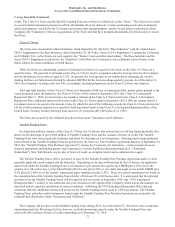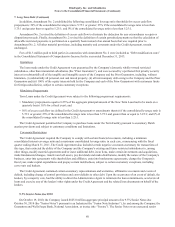IHOP 2014 Annual Report Download - page 89
Download and view the complete annual report
Please find page 89 of the 2014 IHOP annual report below. You can navigate through the pages in the report by either clicking on the pages listed below, or by using the keyword search tool below to find specific information within the annual report.DineEquity, Inc. and Subsidiaries
Notes to the Consolidated Financial Statements (Continued)
2. Basis of Presentation and Summary of Significant Accounting Policies (Continued)
70
for a fixed rental plus, in certain instances, percentage rentals based on gross sales. The rental payments or receipts on leases
that meet the operating lease criteria are recorded as rental expense or rental income, respectively. Rental expense and rental
income for these operating leases are recognized on the straight-line basis over the original terms of the leases. Any difference
between straight-line rent expense or income and actual amounts paid or received represents deferred rent and is included in the
consolidated balance sheets as other assets or other liabilities, as appropriate.
The rental payments or receipts on those property leases that meet the capital lease criteria result in the recognition of
interest expense or interest income and a reduction of capital lease obligation or financing lease receivable, respectively.
Capital lease obligations are amortized based on the Company's incremental borrowing rate and direct financing leases are
amortized using the implicit interest rate.
The lease term used for straight-line rent expense is calculated from the date the Company obtains possession of the leased
premises through the lease termination date. The Company records rent from the possession date through restaurant open date
as expense. Once a restaurant opens for business, the Company records straight-line rent over the lease term plus contingent
rent to the extent it exceeded the minimum rent obligation per the lease agreement. The Company uses a consistent lease term
when calculating depreciation of leasehold improvements, when determining straight-line rent expense and when determining
classification of its leases as either operating or capital. For leases that contain rent escalations, the Company records the total
rent payable during the lease term, as determined above, on the straight-line basis over the term of the lease (including the rent
holiday period beginning upon our possession of the premises), and records the difference between the minimum rents paid and
the straight-line rent as a lease obligation. Certain leases contain provisions that require additional rental payments based upon
restaurant sales volume (“contingent rent”). Contingent rentals are accrued each period as the liabilities are incurred, in addition
to the straight-line rent expense noted above.
Certain lease agreements contain tenant improvement allowances, rent holidays and lease premiums, which are amortized
over the shorter of the estimated useful life or lease term. For tenant improvement allowances, the Company also records a
deferred rent liability or an obligation in non-current liabilities on the consolidated balance sheets and amortizes the deferred
rent over the term of the lease as a reduction to company restaurant expenses in the consolidated statements of comprehensive
income.
Pre-opening Expenses
Expenditures related to the opening of new or relocated restaurants are charged to expense when incurred.
Advertising
Franchise fees designated for IHOP's national advertising fund and local marketing and advertising cooperatives are
recognized as revenue as the fees are earned and become receivables from the franchisee in accordance with U.S. GAAP
governing the accounting for franchise fee revenue. In accordance with U.S. GAAP governing advertising costs, related
advertising obligations are accrued and the costs expensed at the same time the related revenue is recognized. Due to different
contractual terms in Applebee's marketing agreements, franchise fees designated for Applebee's national advertising fund and
local advertising cooperatives constitute agency transactions and are not recognized as revenues and expenses. In both cases,
the advertising fees are recorded as a liability against which specific costs are charged. Advertising fees included in IHOP
franchise revenue and expense for the years ended December 31, 2014, 2013 and 2012 were $90.3 million, $79.5 million and
$76.4 million, respectively.
Advertising expense reflected in the consolidated statements of comprehensive income includes local marketing
advertising costs incurred by company-operated restaurants, contributions to the national advertising fund made by Applebee's
and IHOP company-operated restaurants and certain advertising costs incurred by the Company to benefit future franchise
operations. Costs of advertising are expensed either as incurred or the first time the advertising takes place. Advertising
expense included in company restaurant operations for the years ended December 31, 2014, 2013 and 2012 was $2.9 million,
$2.9 million and $13.1 million, respectively. The decline from 2012 to 2013 was due to the decrease in the number of
Applebee's company-operated restaurants.



